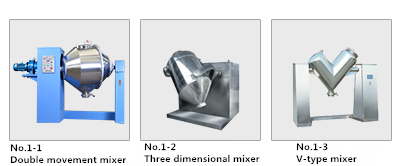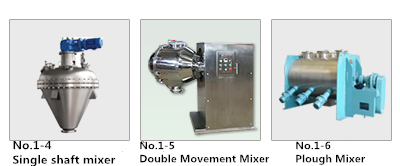Powder Mixing Principle
First, the principle of powder mixing
1) Diffusion mixing - small-scale layered powder diffusion movement,separated by the force of the powder moved to the newly emerging level, so that the various components of the powder in the local area to achieve the spread of uniform distribution. Diffusion mixing conditions are: powder movement distribution in the emerging reborn level.
2) Convective mixing - large-scale random movement of powder, powder under the action of external force produces a fluid-like movement, the powder from one place to another material displacement, the powder in a wide range of convection to achieve uniform distribution .
3) Shear Mixing - shearing the powder material inside, under the action of external force, mutual slip phenomenon occurs between the powder, forming a slip surface, so that the local powder is continuously sheared to achieve uniform distribution.
Although the above three mixing principles are different, their common essence is that the application of appropriate external force causes the relative displacement of various components in the mixture, which is a necessary condition for mixing.
Second, the implementation of powder mixing methods
Whether manual or mechanical equipment mixing, powder mixing implementation methods are generally divided into two types.
Gravity convection diffusion mixing method
1) Principle: By continuously raising the center of gravity of the powder, gravity is used to force the powder to repeatedly mix, flow, diffuse, hedge, fold and other motions. Its role is macroscopic powder mixed with each other, infiltration, so as to achieve the purpose of mixing evenly.
2) Advantages and Disadvantages: Advantages and Disadvantages of Gravity Convection Diffusion-type mixing method is that macroscopically the powder flows rapidly in the container and can be made up and down and left and right in the container basically uniform. The disadvantage is that between microscopic adjacent particles , Local space changes slowly, unable to meet the requirements of the fine mix.
3) Representative models: Mixer using this principle are: double movement mixer, three-dimensional mixer, v-mixer, double cone mixer and so on. It is characterized by driving the container with powder material to move, forcing the powder in the container to carry out gravity convection and diffusion mixing under the action of gravity (as 1-1, 1-2 and 1-3).

Forced shear mixing type mixing method
1) Principle: The mixing method of forcing the powder to be repeatedly stirred, sheared and the like is forced by the moving blades in the container. Its role is to continuously break up the adjacent relationship between the powder particles microscopically, so that the powder particles fully mobile, interchangeable, to achieve the purpose of powder mixing.
2) Advantages and Disadvantages: Advantages and Disadvantages: The advantages of forced mixing and shearing type mixing method are: to achieve fine and uniform mixing microscopically and to achieve high mixing efficiency due to the high flow efficiency inside the powder body; the disadvantage is that no effective measures are taken to realize the inside of the container Up and down, macroscopically or so on the whole uniform.
3) Representative models: Mixer using this principle are: double movement mixer, trough ribbon mixer, single cone screw mixer, coulter mixer and so on. The utility model is characterized in that a movement paddle device is added in the container, and the powder is subjected to forced mixing and shear mixing (as 1-4, 1-5, 1-6).
In practice, mixing devices are not only based on a certain mixing principle, but also on other mixing principles.